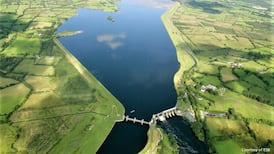A pair of trousers bought in Penneys and later put in a clothing bank in Dublin has travelled through Poland, Germany and was last seen in Libya.
That is according to preliminary data from a forthcoming report tracking the journeys of new and second-hand trousers, jumpers and shirts.
The tracked clothing is from retailers’ take-back schemes or commercial clothing banks.
The Threads of Truth project, led by environmental charity Voice Ireland, found many items of clothing travel thousands of kilometres away to countries in the Middle East and Africa, often several months after they were donated.
READ MORE
“We have seen that clothes are going all over the world,” says Solene Schirrer, project leader with Voice Ireland.
[ Use your clothes for nine months more and reduce their environmental footprint by up to 30% ]
Of the 35 items initially fitted with the tracking devices, 27 have been monitored on their journeys across Europe to destinations as far as Togo in west Africa, the United Arab Emirates, Kenya, Pakistan and Libya.
Each item of clothing is tracked using an Apple air tag from when it was put into a clothing bank or a take-back scheme to its current destination eight months later.

The project, which has partnered with the Dublin hub of the international youth organisation Global Shapers, will make its map live on August 18th enabling the public to follow the journey of these clothes. The project participants plan to continue to track each item of clothing for their final report due in October 2025.
Take, for example, a pair of black jogging pants dropped into H&M’s take-back scheme in Dublin in December 2024. They travelled from Dublin Port to Rotterdam, later moving to Polch in Germany, then to Szecseny in Hungary and back to Regensburg in Germany and on to Hunxe in Germany, where they remain.
“We assume that this black jogging pants has arrived at a recycling site specialised in making high-quality secondary building materials,” says Ms Schirrer.

Or, consider a blue and red striped shirt, dropped off at a clothing bank in Ranelagh, Dublin, in March 2025. It moved from there to Gniezno in Poland, after which it arrived in a residential street in the city. “We disable the tags once the item arrives in an residential street and we offer the customer an opportunity to contact us,” explains Ms Schirrer.
Voice Ireland has not yet heard back from end users. Children’s clothes weren’t included in the Threads for Truth project.
Although many items remain in storage at industrial warehouses in Europe, Ms Schirrer says there are concerns some items have been shipped to already over-subscribed clothing markets in African countries.
She hopes that by highlighting the long, often circuitous journeys discarded textiles take, clothing manufacturers, retailers and textile recyclers will be forced to be more transparent about where textiles end up.
[ How to save water: The average Irish person uses 133 litres a dayOpens in new window ]

“We should have greater transparency and traceability of clothes and a code of conduct for operators in Ireland and their contractors in foreign countries,” says Ms Schirrer.
In May 2024, the EU adopted the Waste Shipment regulation, which prevents the shipment of unsorted textiles outside the EU. Also, from January 2025, separate collection of textiles became mandatory in each EU country.
In a 2024 report on EU exports of used textiles, the European Environment Agency noted that export of used textiles – mainly to African and Asian countries from EU countries – more than doubled in almost 20 years. The authors suggested mandatory separate collection of textile waste will lead to increased volumes of clothing for export.
Ms Schirrer hopes the Threads of Truth project will not only draw attention to the destination of EU textiles but also compel EU regulators to ensure correct payment across the industry.
“A lot of people say we still need to export clothes as there are markets abroad. But, there should be stricter legislation to ensure that exported clothes are reused and recycled and not landfilled in other countries,” she says.
She argues that extended producer responsibility (EPR) regulations, which require clothing manufacturers to pay towards the end-of-life schemes for textiles, should take into account exactly who deals with the clothes at the end of their lives.
“To have a fair industry, an EPR scheme needs to give money to the right people who are reusing and recycling their clothes. So, if a piece of clothing ends up in Togo, the merchant there should get part of the EPR fee.”
The EU EPR scheme is expected to become mandatory by 2028.
When contacted about the destination of clothing in its take-back schemes, H&M said it works with the Swedish company Looper Textile Co (which has textile sorting and recycling facilities in Polch and Hamburg in Germany and in Pila in Poland) as well as local partners in China, Japan and India.
In 2024, H&M reported that 66 per cent of clothes dropped through its take-back scheme were sorted for reuse, 24 per cent for recycling and 10 per cent for disposal.
“Based on the data we received from our sorting partner Looper Textile Co, 35.3 per cent of sorted items were sold for reuse within Europe in 2024. Outside of Europe, Looper has partners in Asia, Africa and the US,” a spokesperson said.
A spokeswoman for Primark (Penneys) said Yellow Octopus Circular Solutions, a sorting and recycling company registered in England and Poland, manages its take-back scheme. She said: “Every item is sorted and graded, and clean items in good condition are resold in independent clothing stores and retailers trading second-hand clothing in seven countries approved by Primark.
“Items that can’t be resold are recycled and turned into new products, like mattress filling,” she added. In Ireland in 2024, 97.72 tonnes of textiles were collected in Penneys stores, with 71 per cent of those items deemed suitable for resale, and 29 per cent recycled.
A spokesperson from M&S said all clothes from its take-back scheme are sent to Oxfam charity shops for resale or recycling.
Clothes Pod, one of the largest commercial operators of clothing banks in Ireland did not respond to queries regarding which countries clothes from their clothing banks go to.





















